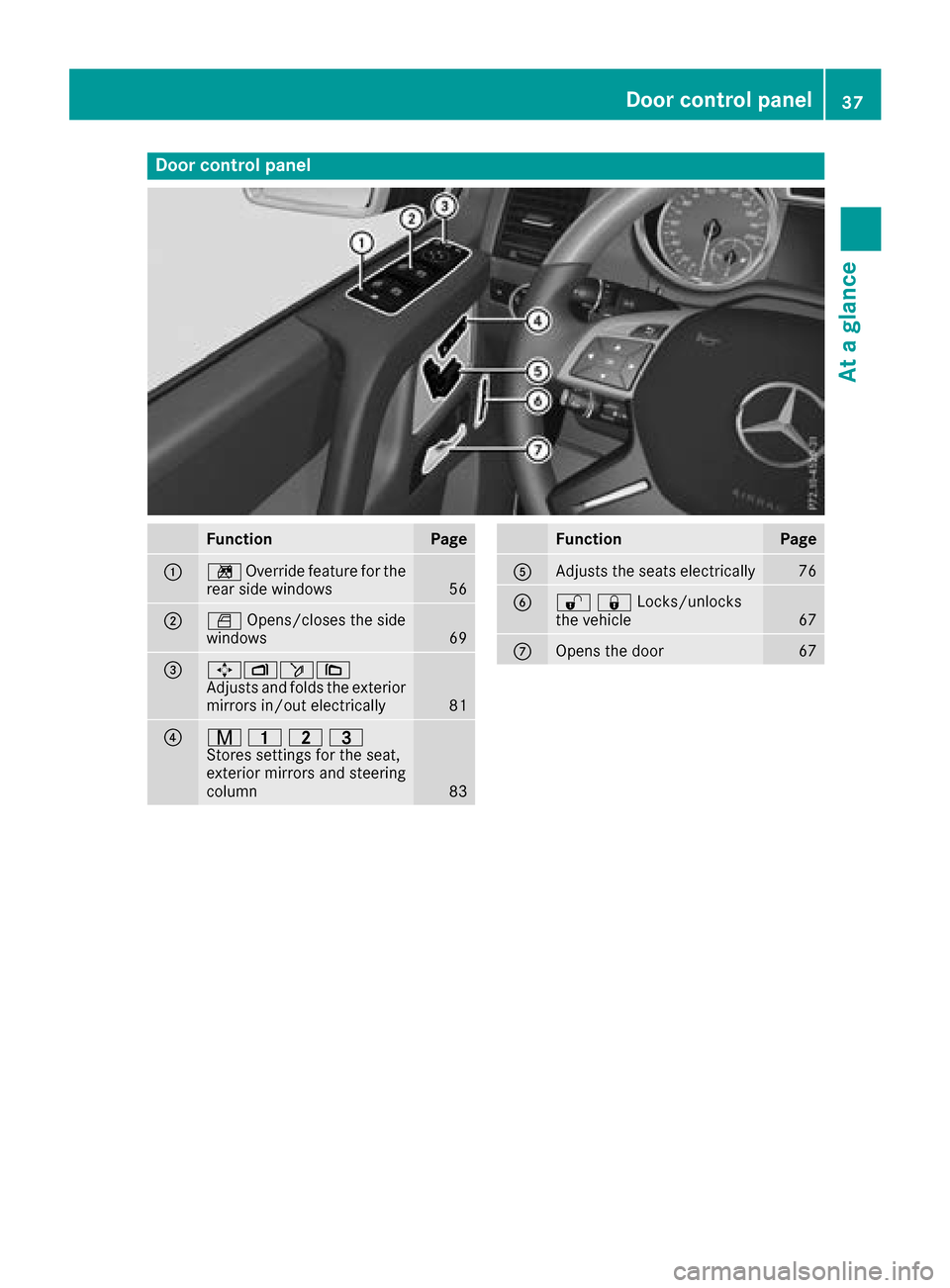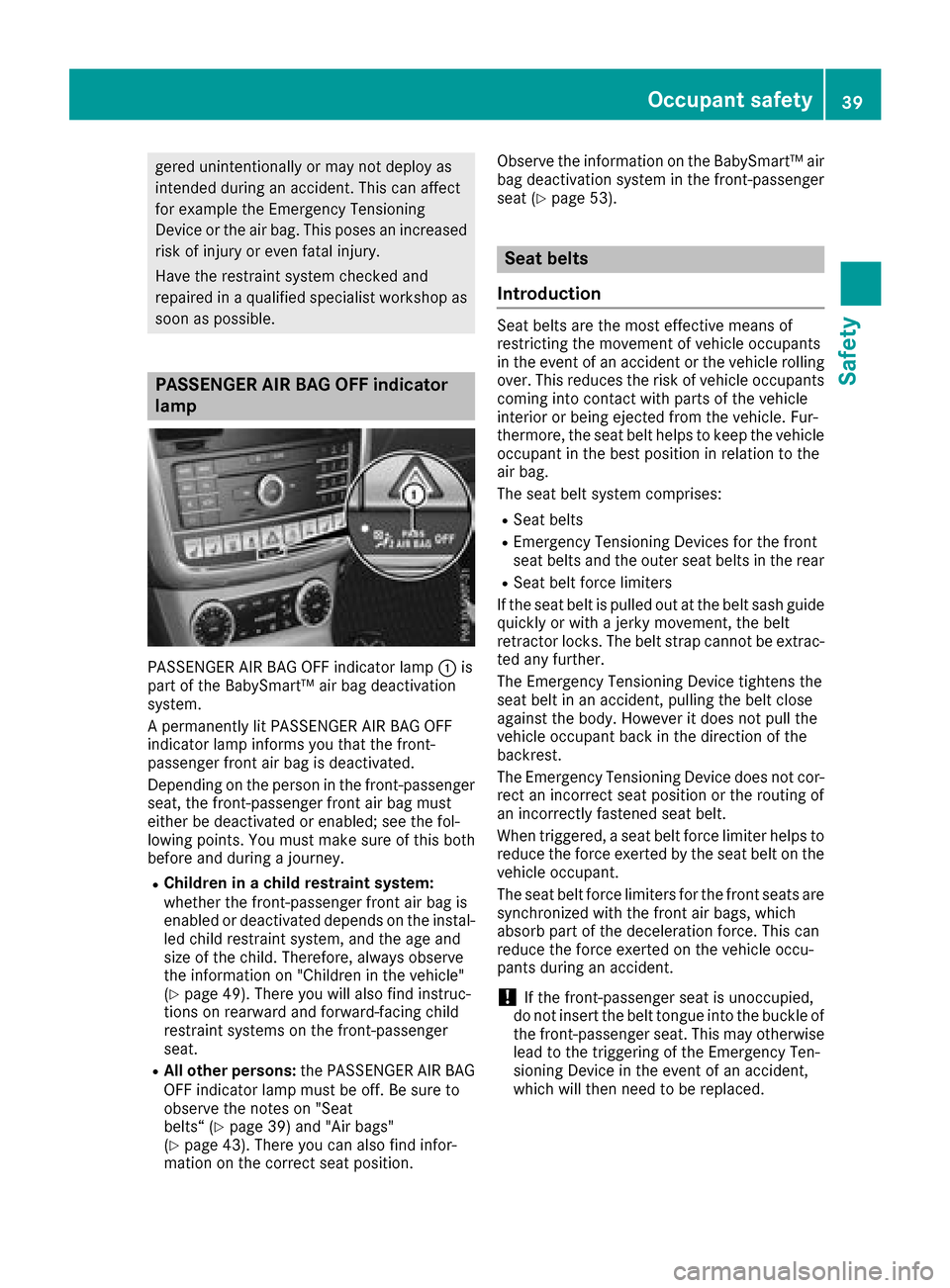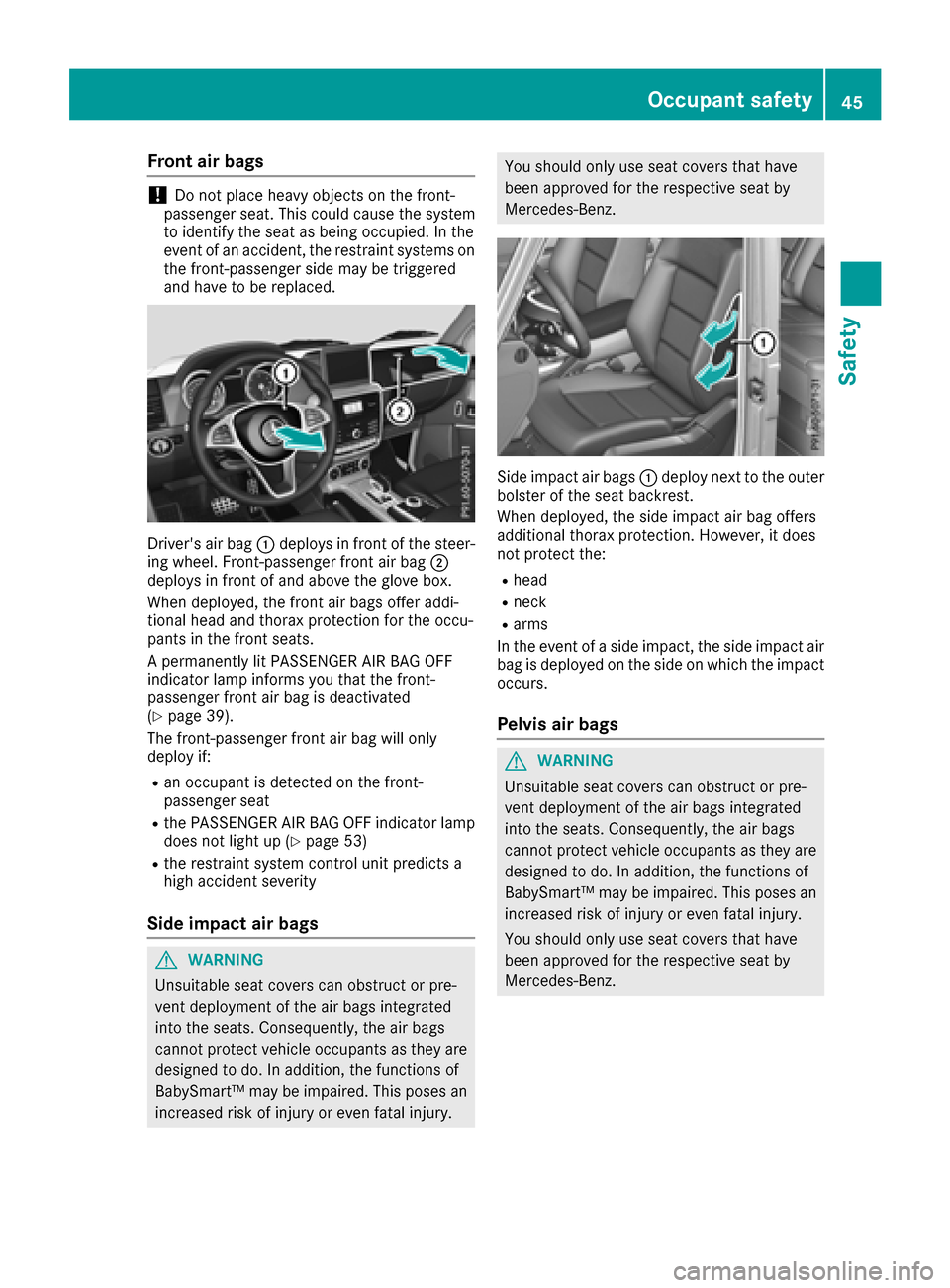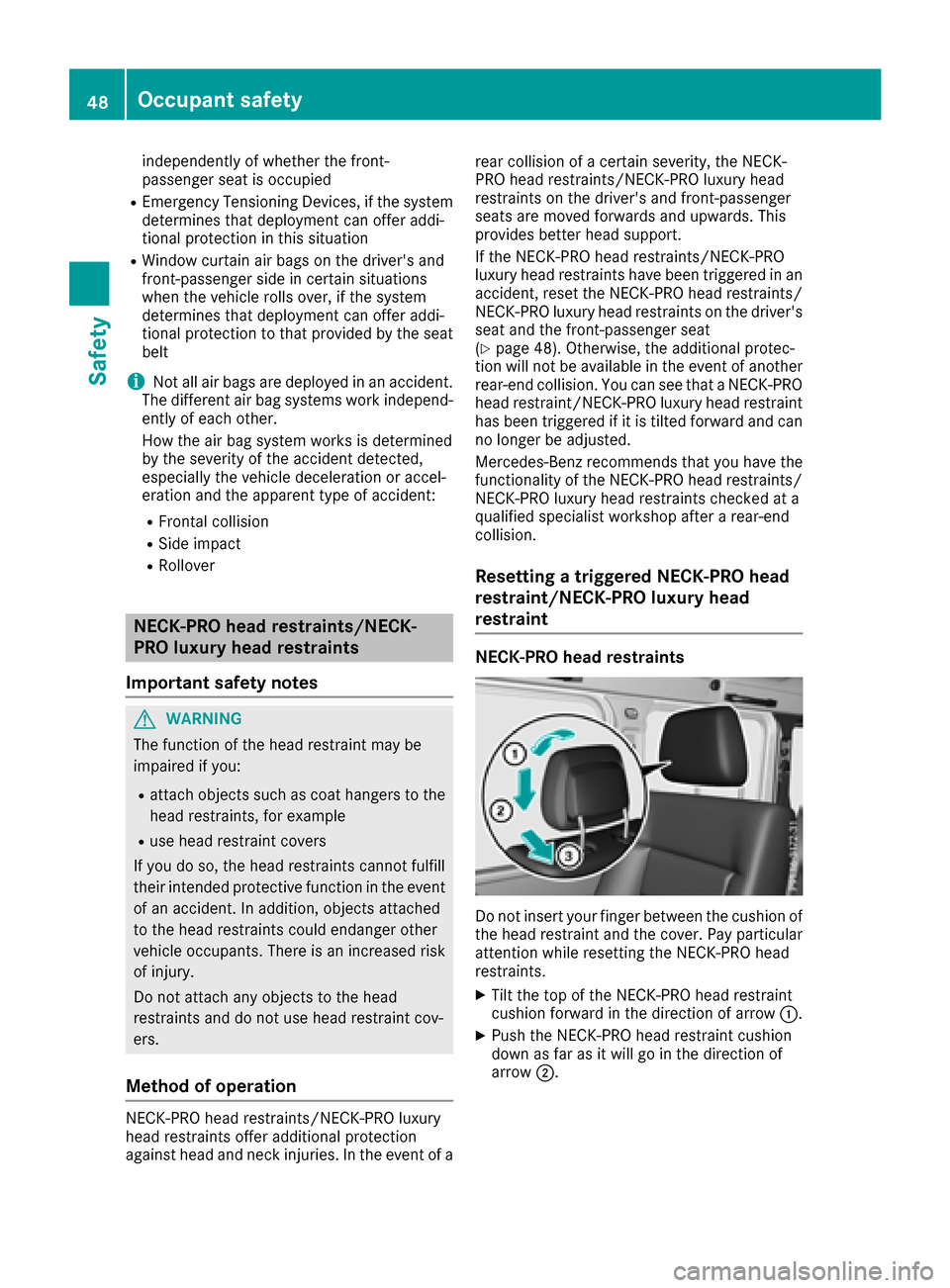2017 MERCEDES-BENZ G-Class seats
[x] Cancel search: seatsPage 4 of 286

Index....................................................... 4
Digital Operator's Manual..................22
Introductio n........................................... 22
Operation ............................................... 22
Introduction ......................................... 23
Protecting the environment ...................2 3
Genuine Mercedes-Ben zparts............... 23
Operator's Manual ................................. 24
Service and vehicle operation ................2 4
Operating safety .................................... 26
QR codes for rescue cards .................... 28
Data stored in the vehicle ......................2 8
Information on copyright ....................... 29
At ag lance ........................................... 31
Cockpit .................................................. 31
Instrument cluster .................................3 2
Multifunction steering wheel ................. 33
Center console ...................................... 34
Overhead control panel .........................3 6
Doorc ontrolpan el ................................. 37
Safety ................................................... 38
Occupant safety .................................... 38
Childre ninthe vehicl e........................... 49
Pets in the vehicl e................................. 57
Driving safety systems ........................... 57
Protection against theft .........................6 1
Opening and closing...........................63
SmartKey ............................................... 63
Doors ..................................................... 66
Rear door ............................................... 68
Side windows ......................................... 69
Sliding sunroof ....................................... 71
Seats, steering wheel and mirrors ....74
Correct driver's seat position ............... .74
Seats ..................................................... 74
Steering wheel ....................................... 79
Mirrors. .................................................. 81
Memory functions .................................. 83
Lights and windshield wipers ............85
Exterior lighting ..................................... 85
Interior lighting ...................................... 88
Replacing bulb s..................................... 88
Windshield wipers .................................. 92
Climate control .................................... 95
Overview of the climate control sys-
tem ........................................................ 95
Operating the climate control system .... 97
Air vents .............................................. 101
Drivin gand parking .......................... 103
Notesonb reaking-inanew vehicl e..... 103
Driving ................................................. 103
Adjustable damping ............................. 109
Automati ctransmissio n....................... 109
Refueling ............................................. 118
Parking ................................................ 120
Driving tip s.......................................... 122
Driving systems ................................... 131
Off-road driving systems ...................... 145
Towing atraile r.................................... 149
On-board computer and displays ....157
Important safety notes ........................ 157
Displays and operation ........................ 157
Menusa nd submenus ......................... 159
Displa ymessages ............................... 169
Warning and indicator lamps in the
instrument cluster ............................... 187
Multimedi asystem ........................... 198
Generaln otes ...................................... 198
Important safety notes ........................ 198
Function restrictions ............................ 198
Operating system ................................ 199
Stowag eand features ...................... 204
Loading guideline s............................... 204
Stowag eareas ..................................... 205
Feature s.............................................. 210
2Contents
Page 18 of 286

Removing....................................... 20 3
SD memory card
seea lsoD igita lOperator's Man-
ua l..................................................1 98
Search&S end
see also Digita lOperator's Man-
ua l..................................................1 98
Seat backrest
Folding back .................................. 207
Seat belts
Adjusting the height ......................... 41
center rear-compartment seat. ........ 42
Cleaning ......................................... 237
Correct usag e.................................. 41
Fastening ......................................... 41
Important safety guideline s............. 40
Introduction ..................................... 39
Releasing ......................................... 43
Warning lamp ................................. 188
Warning lamp (function) ................... 43
Seat heating
Indicato rlam p(malfunction) ............ 79
Seat ventilation
Indicato rlam p(malfunction) ............ 79
Seats
Adjusting (electrically) ..................... 76
Adjusting the 4-wa ylum bars up-
por t.................................................. 78
Adjusting the headr estraint ............ 76
Cleaning the cover. ........................ 236
Correct driver'ss eatposition ........... 74
Important safety notes .................... 74
Overview .......................................... 74
Storing settings (memory func-
tion) ................................................. 83
Switching seath eating on/off......... 78
Switching seatv entilation on/off. ... 79
Selecto rlever
Cleaning ......................................... 236
Sensors (cleaning instructions) ....... 234
Servic einterva ldisplay
Displaying aservice message (on-
board computer) ............................ 231
Servic emenu( on-board com-
puter) .................................................. 164
Servic eproducts
Brake fluid ..................................... 279
Coolant (engine) ............................ 279 Engine oil.
...................................... 278
Fue l................................................ 276
Important safety notes .................. 276
Notes. ............................................ 276
Refrigerant (air-conditioni ng sy
s-
tem) ............................................... 280
Washerf luid ................................... 280
Setting the air distribution ................. 98
Setting the date/time format
see also Digital Operator's Man-
ual.................................................. 198
Setting the language
see also Digital Operator's Man-
ual.................................................. 198
Setting the time
see also Digital Operator's Man-
ual.................................................. 198
Settings
Calling up astoreds etting ............... 84
Factory (on-board computer) ......... 167
On-board compute r....................... 164
SETUP (on-board computer,
Mercedes-AMG vehicles) .................. 168
Shift ranges ....................................... 114
Side impac tair bag ............................. 45
Side marker lamp (display mes-
sage) ................................................... 176
Side windows
Convenience closing feature ............ 70
Convenience opening feature .......... 70
Important safety information ........... 69
Opening/closing .............................. 69
Overview .......................................... 69
Problem (malfunction) ..................... 70
SIRIU Sservices
see also Digital Operator's Man-
ua l.................................................. 198
Sliding sunroof
Important safety notes .................... 71
Opening/closing .............................. 72
Operating manually .......................... 72
Problem (malfunction) ..................... 73
SmartKey
Changing the battery ....................... 65
Changing the programming ............. 64
Checking the battery ....................... 65
Convenience closing feature ............ 70
16Index
Page 25 of 286

Protecting the environment
General notes
HEnvironmental note
Daimler's declared policy is one of compre-
hensive environmental protection.
The objectives are for the natural resources
that form the basis of our existence on this
planet to be used sparingly and in amanner
that takes the requirements of both nature
and humanity into account.
You too can help to protect the environment
by operating your vehicle in an environmen-
tally responsible manner.
Fuel consumption and the rate of engine,
transmission, brake and tire wear are affected by these factors:
Roperating conditionsofy our vehicle
Ryour personal driving style
You can influence both factors. You should
bear the following in mind:
Operating conditions:
Ravoid short trips as these increase fuel con-
sumption.
Ralways make sure that the tire pressures
are correct.
Rdo not carry any unnecessary weight.
Rremove roof racks once you no longer need
them.
Rar egularly serviced vehicle will contribute
to environmental protection. You should
therefore adhere to the service intervals.
Ralways have service work carried out at a
qualified specialist workshop.
Personal driving style:
Rdo not depress the accelerator pedal when
startin gthe engine.
Rdo not warm up the engine when the vehicle
is stationary.
Rdrive carefully and maintain asafe distance
from the vehicle in front.
Ravoid frequent, sudden acceleration and
braking.
Rchange gear in good time and use each gear
only up to Ôof its maximum engine speed.
Rswitch off the engine in stationary traffic.
Rkeep an eye on the vehicle's fuel consump-
tion.
Environmental concerns and recom-
mendations
Wherever the Operator's Manual requires you to
dispose of materials, first try to regenerate or re-
use them. Observe the relevant environmental
rules and regulations when disposing of materi-
als. In this way you will help to protect the envi-
ronment.
Genuine Mercedes-Benz parts
HEnvironmental note
Daimler AG also suppliesr econditioned major
assemblies and parts which are of the same
quality as new parts. They are covered by the
same Limited Warranty entitlements as new
parts.
!Air bags and Emergency Tensioning Devi-
ces, as well as control units and sensors for
these restraint systems, may be installed in
the following areas of your vehicle:
Rdoors
Rdoor pillars
Rdoor sills
Rseats
Rcockpit
Rinstrumentc luster
Rcenter console
Do not install accessories such as audio sys-
tems in these areas. Do not carry out repairs or welding. You could impair the operating
efficiency of the restraint systems.
Have aftermarket accessories installed at a
qualified specialist workshop.
You could jeopardize the operating safety of
your vehicle if you use parts, tires and wheels as
well as accessories relevant to safety which
have not been approved by Mercedes-Benz. This
could lead to malfunction sinsafety-relevant
Genuine Mercedes-Benz parts23
Introduction
Z
Page 39 of 286

Door controlpanel
FunctionPage
:n Override feature fo rthe
rea rsidew indows56
;W Opens/closes th eside
windows69
=7Z ö\
Adjust sand folds th eexter ior
mirrors in/out electrically
81
?r 45=
Stores settings for the seat,
exterior mirrors and steering
column
83
FunctionPage
AAdjusts the seats electrically76
B%&Locks/unlocks
the vehicle67
COpens the door67
Door control panel37
At ag lance
Page 41 of 286

gered unintentionally or may not deploy as
intended during an accident.This can affect
for example the Emergency Tensioning
Device or the air bag. This poses an increased
risk of injury or even fatal injury.
Have the restraint system checked and
repaired in aqualified specialist workshop as
soon as possible.
PASSENGER AIR BAG OFF indicator
lamp
PASSENGER AIR BAG OFF indicator lamp :is
part of the BabySmart™ air bag deactivation
system.
Ap ermanently lit PASSENGER AIR BAG OFF
indicator lamp informs you that the front-
passenger front air bag is deactivated.
Depending on the person in the front-passenger
seat, the front-passenger front air bag must
either be deactivated or enabled; see the fol-
lowing points. You must make sure of this both
before and during ajourney.
RChildren in achild restraint system:
whether the front-passenger front air bag is
enabled or deactivated depends on the instal- led child restraint system, and the age and
size of the child. Therefore, always observe
the information on "Children in the vehicle"
(
Ypage 49). There you will also find instruc-
tions on rearward and forward-facingc hild
restraint systems on the front-passenger
seat.
RAll other persons: the PASSENGER AIR BAG
OFF indicator lamp must be off. Be sure to
observe the notes on "Seat
belts“ (
Ypage 39) and "Air bags"
(Ypage 43). There you can also find infor-
mation on the corrects eat position. Observe the information on the BabySmart™ air
bag deactivation system in the front-passenger
seat (
Ypage 53).
Seat belts
Introduction
Seat belts are the most effective means of
restricting the movement of vehicle occupants
in the event of an accident or the vehicle rolling
over. This reduces the risk of vehicle occupants
coming into contact with parts of the vehicle
interior or being ejected from the vehicle. Fur-
thermore, the seat belt helps to keep the vehicle
occupant in the best position in relation to the
air bag.
The seat belt system comprises:
RSeat belts
REmergency Tensioning Devices for the front
seat belts and the outer seat belts in the rear
RSeat belt force limiters
If the seat belt is pulled out at the belt sash guide
quickly or with ajerk ym ovement ,the belt
retractor locks. The belt strap cannot be extrac-
ted any further.
The Emergency Tensioning Device tighten sthe
seat belt in an accident,p ulling the belt close
against the body. However it does not pull the
vehicle occupant back in the direction of the
backrest.
The Emergency Tensioning Device does not cor-
rect an incorrect seat position or the routing of
an incorrectly fastened seat belt.
When triggered, aseat belt force limiter helps to
reduce the force exerted by the seat belt on the
vehicle occupant.
The seat belt force limiters for the front seats are
synchronized with the front air bags, which
absorb part of the deceleration force. This can
reduce the force exerted on the vehicle occu-
pants during an accident.
!If the front-passenger seat is unoccupied,
do not insert the belt tongue into the buckle of
the front-passenger seat. This may otherwise
lead to the triggering of the Emergency Ten-
sioning Device in the event of an accident,
which will then need to be replaced.
Occupant safety39
Safety
Z
Page 46 of 286

To avoid hazardous situations, alwaysmake
sure that all of the vehicle's occupants:
Rhave fastened their seat belts correctly,
including pregnant women
Rare sittin gcorrectly and maintain the great-
est possible distance to the air bags
Rfollow the following instructions
Always make sure that there are no objects
between the air bag and the vehicle's occu-
pants.
RAdjust the seats properly before beginning
your journey. Always make sure that the seat
is in an almost upright position. The center of
the head restraint must support the head at
about eye level.
RMove the driver's and front-passenger seats
as far back as possible. The driver's seat posi-
tion must allow the vehicle to be driven safely.
ROnly hold the steerin gwheel on the outside.
This allows the air bag to be fully deployed.
RAlways lean against the backrest while driv-
ing. Do not lean forwards or lean against the
door or side window. You may otherwise be in
the deployment area of the air bags.
RAlways keep your feet in the footwell in front
of the seat. Do not put your feet on the dash-
board, for example. Your feet may otherwise
be in the deployment area of the air bag.
RFor this reason, alwayss ecure persons less
than 5ft(1.50 m) tall in suitable restraint sys-
tems. Up to this height, the seat belt cannot
be worn correctly.
If ac hild is traveling in your vehicle, also
observe the followingn otes:
RAlways secure children under twelve years of
age and less than5ft(1.50 m)tallins uitable
child restraint systems.
RChil drestraint systems shoul dbeinstalle don
the rea rseats.
ROnlys ecureac hild in arearward-facing child
restraint systemont he front-passengerseat
when the front-passengerf ront airbag is
deactivated .Ifthe PASSENGER AIR BAG OFF
indicator lamp is permanentl ylit,t he front-
pa sseng
e
rfront ai rbag is deactivated
(Ypage 39).
RAlway sobser ve the instructions and safety
note son" Childr en in the vehicle"
(
Ypage 49 )and on the "Child restraint sys- tem on the front-passenge
rseat"
(
Ypage 54 )inadditiontot he child restraint
systemm anufacturer's installatio nand oper-
ating instructions.
Objects in the vehicle interior may prevent
an air bag fromf unctioningcorrectly. Before
startin gyourjourney and to avoi drisks resulting
fromt he spee dofthe airbag as it deploys, make
sure that:
Rthere ar enopeople, animals or objects
between the vehicl eoccupants and an ai rbag
Rthere ar enoobjects between the seat, door
and B-pillar
Rthere ar enohardo bjects ,e.g.c oa th angers,
hanging on the gra bhandles or coa thooks
Rno accessories, such as cup holders, are
attache dtothe vehicl ewithint he deployment
area of an ai rbag,e.g.tod oors,s idew indows,
rea rsidet rim or side walls
Rno heavy, sharp-edged or fragile objects ar ein
the pockets of your clothing. Store such
objects in asuitabl eplace
GWARNING
If yo umodify the ai rbag cove rora ffix objects
such as sticker stoit, the ai rbag can no longer
functio ncorrectly. There is an increasedr isk
of injury.
Never modify an ai rbag cove rora ffix objects
to it.
GWARNING
Sensors to control the ai rbagsa relocate din
the doors .Modifications or work not per-
formed correctl ytothe doors or door panel-
ing ,asw ellasd amaged doors,can lead to the
functio nofthe sensors being impaired. Th eair
bags might therefore not functio nproperly
anymore. Consequently, the ai rbagsc annot
protect vehicl eoccupants as theya re
designe dtodo.There is an increasedr isko f
injury.
Never modify the doors or parts of the doors.
Alway shavew orkont he doors or door pan-
eling carrie doutataq uali fied specialis twork-
shop.
44Occupant safety
Safety
Page 47 of 286

Frontair bags
!Do no tplac eh eav yobject sont hefront-
passenger seat .This could caus ethe system
to identify th eseat as bein goccupied. In th e
event of an accident, th erestrain tsystems on
th ef ront-pa ssenger side may be triggered
and have to be replaced.
Driver's air bag :deploys in fron tofthesteer -
ing wheel. Front-passenger fron tair bag ;
deploys in fron tofand abov ethe glov ebox.
When deployed, th efront air bags offer addi-
tional head and thorax protection for th eoccu-
pants in th efront seats.
Ap ermanentl ylit PASSENGER AI RBAG OFF
indicator lamp inform syou that th efront -
passenger fron tair bag is deactivated
(
Ypage 39).
The front-passenger fron tair bag will only
deplo yif:
Ran occupant is detected on th efront -
passenger seat
Rth eP ASSENG ER AIRBAG OFFindicator lamp
does no tligh tup(Ypage 53 )
Rther estrain tsystem control unit predicts a
high acciden tseverit y
Sidei mpact air bags
GWARNIN G
Unsuitable seat cover scan obstruc torpre-
ven tdeploymen toftheair bags integrate d
int ot he seats. Consequently, th eair bags
canno tprotect vehicl eoccupant sastheya re
designed to do. In addition ,the function sof
BabySmart ™may be impaired .This pose san
increased ris kofinjury or eve nfatal injury.
You should only use seat cover sthath ave
been approve dfor th erespective seat by
Mercedes-Benz.
Sid eimpac tair bags :deplo ynexttot heouter
bolste roftheseat backrest .
When deployed, th eside impac tair bag offers
additional thorax protection .How ever, it does
no tp rotect the:
Rhead
Rneck
Rarm s
In th eevent of aside impact ,the side impac tair
bag is deployed on th eside on whic hthe impac t
occurs.
Pelvisa ir bags
GWARNIN G
Unsuitable seat cover scan obstruc torpre-
ven tdeploymen toftheair bags integrate d
int ot he seats. Consequently, th eair bags
canno tprotect vehicl eoccupant sastheya re
designed to do. In addition ,the function sof
BabySmart ™may be impaired .This pose san
increased ris kofinjury or eve nfatal injury.
You should only use seat cover sthath ave
been approve dfor th erespective seat by
Mercedes-Benz.
Occupant safety45
Safety
Z
Page 50 of 286

independently of whether the front-
passenger seat is occupied
REmergency TensioningDevices, if the system
determines that deploymentc an offer addi-
tional protection in this situation
RWindo wcurtain air bags on the driver's and
front-passenge rside in certain situations
when the vehicle rolls over,ift he system
determines that deploymentc an offer addi-
tional protection to that provided by the seat
belt
iNot all air bags are deployed in an accident.
The differenta ir bag systems work independ-
ently of each other.
How the air bag system worksisd etermined
by the severity of the accident detected,
especially the vehicle deceleratio noraccel-
eration and the apparentt ype of accident:
RFrontal collision
RSide impact
RRollover
NECK-PRO head restraints/NECK-
PRO luxury head restraints
Important safetyn otes
GWARNING
The function of the head restraint may be
impaired if you:
Rattach object ssuch as coat hangers to the
head restraints, for example
Ruse head restraint covers
If you do so, the head restraint scannot fulfill
their intended protective function in the event of an accident .Inaddition ,object sattached
to the head restraint scould endanger other
vehicle occupants. There is an increased risk
of injury.
Do not attach any object stothe head
restraint sand do not use head restraint cov-
ers.
Method of operation
NECK-PRO head restraints/NECK-PRO luxury
head restraint soffer additional protection
against head and nec kinjuries. In the eventofa rear collision of
acertain severity, the NECK-
PRO head restraints/NECK-PRO luxury head
restraint sonthe driver's and front-passenger
seats are movedf orwards and upwards. This
provides better head support.
If the NECK-PRO head restraints/NECK-PRO
luxury head restraint shave been triggeredina n
accident ,reset the NECK-PRO head restraints/
NECK-PRO luxury head restraint sonthe driver's
seat and the front-passenge rseat
(
Ypage 48). Otherwise, the additional protec-
tion will not be available in the eventofa nother
rear-end collision. You can see that aNECK-PRO
head restraint/NECK-PRO luxury head restraint
has been triggeredifitist ilted forward and can
no longer be adjusted.
Mercedes-Ben zrecommends that you have the
functionality of the NECK-PRO head restraints/
NECK-PRO luxury head restraint schecked at a
qualified specialist workshop after arear-end
collision.
Resetting atriggered NECK-PRO head
restraint/NECK-PRO luxury head
restraint
NECK-PRO head restraints
Do not insert your finger betwee nthe cushio nof
the head restraint and the cover. Pay particular
attention while resettin gthe NECK-PRO head
restraints.
XTilt the top of the NECK-PRO head restraint
cushio nforward in the direction of arrow :.
XPush the NECK-PRO head restraint cushion
down as far as it will go in the direction of
arrow;.
48Occupant safety
Safety